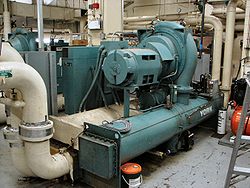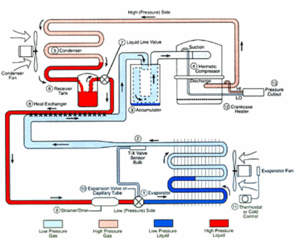Difference between revisions of "Chillers"
| (One intermediate revision by the same user not shown) | |||
| Line 1: | Line 1: | ||
A | [[Category:Cooling]]{{Knoppen}} | ||
<noinclude><!------------------------------------------------ | |||
* READ THIS FIRST | |||
* Only edit this page if you can improve the content. | |||
* Improper use of this page will lead to permanent banning. | |||
* Please do not edit the sponsored link on the top right corner. | |||
* Please start editing this page after the /noinclude | |||
* -------------------------------------------------></noinclude> | |||
[[File:Chiller.jpg|thumb|right|Chiller]] | |||
[[File:Mechanical-chillers.gif|thumb|right|Mechanical Chiller]] | |||
A '''Chiller''' is a machine that removes heat from a liquid via a vapor-compression or absorption refrigeration cycle. This liquid can then be circulated through a [[Heat Exchangers]] to cool air or equipment as required. | |||
In industrial application, chilled water or other liquid from the chiller is pumped through process or laboratory equipment. Industrial chillers are used for controlled cooling of products, mechanisms and factory machinery in a wide range of industries. They are often used in the plastic industry in injection and blow molding, metal working cutting oils, welding equipment, die-casting and machine tooling, chemical processing, pharmaceutical formulation, food and beverage processing, paper and cement processing, vacuum systems, X-ray diffraction, power supplies and power generation stations, analytical equipment, semiconductors, compressed air and gas cooling. They are also used to cool high-heat specialized items such as MRI machines and lasers, and in hospitals, hotels and campuses. | In industrial application, chilled water or other liquid from the chiller is pumped through process or laboratory equipment. Industrial chillers are used for controlled cooling of products, mechanisms and factory machinery in a wide range of industries. They are often used in the plastic industry in injection and blow molding, metal working cutting oils, welding equipment, die-casting and machine tooling, chemical processing, pharmaceutical formulation, food and beverage processing, paper and cement processing, vacuum systems, X-ray diffraction, power supplies and power generation stations, analytical equipment, semiconductors, compressed air and gas cooling. They are also used to cool high-heat specialized items such as MRI machines and lasers, and in hospitals, hotels and campuses. | ||
In air conditioning systems, chilled water is typically distributed to heat exchangers, or coils, in air handling units or other type of terminal devices which cool the air in its respective space(s), and then the chilled water is re-circulated back to the chiller to be cooled again. These | In air conditioning systems, chilled water is typically distributed to heat exchangers, or coils, in air handling units or other type of terminal devices which cool the air in its respective space(s), and then the chilled water is re-circulated back to the chiller to be cooled again. These [[Cooling Coils]] transfer sensible heat and latent heat from the air to the chilled water, thus cooling and usually dehumidifying the air stream. A typical chiller for air conditioning applications is rated between 15 and 1500 tons (180,000 to 18,000,000 BTU/h or 53 to 5,300kW) in cooling capacity, and at least one manufacturer can produce chillers up to 6,000 tons of cooling. Chilled water temperatures can range from 35 to 45 degrees Fahrenheit (1.5 to 7 degrees Celsius), depending upon application requirements. | ||
Latest revision as of 10:25, 3 August 2012
A Chiller is a machine that removes heat from a liquid via a vapor-compression or absorption refrigeration cycle. This liquid can then be circulated through a Heat Exchangers to cool air or equipment as required.
In industrial application, chilled water or other liquid from the chiller is pumped through process or laboratory equipment. Industrial chillers are used for controlled cooling of products, mechanisms and factory machinery in a wide range of industries. They are often used in the plastic industry in injection and blow molding, metal working cutting oils, welding equipment, die-casting and machine tooling, chemical processing, pharmaceutical formulation, food and beverage processing, paper and cement processing, vacuum systems, X-ray diffraction, power supplies and power generation stations, analytical equipment, semiconductors, compressed air and gas cooling. They are also used to cool high-heat specialized items such as MRI machines and lasers, and in hospitals, hotels and campuses.
In air conditioning systems, chilled water is typically distributed to heat exchangers, or coils, in air handling units or other type of terminal devices which cool the air in its respective space(s), and then the chilled water is re-circulated back to the chiller to be cooled again. These Cooling Coils transfer sensible heat and latent heat from the air to the chilled water, thus cooling and usually dehumidifying the air stream. A typical chiller for air conditioning applications is rated between 15 and 1500 tons (180,000 to 18,000,000 BTU/h or 53 to 5,300kW) in cooling capacity, and at least one manufacturer can produce chillers up to 6,000 tons of cooling. Chilled water temperatures can range from 35 to 45 degrees Fahrenheit (1.5 to 7 degrees Celsius), depending upon application requirements.

